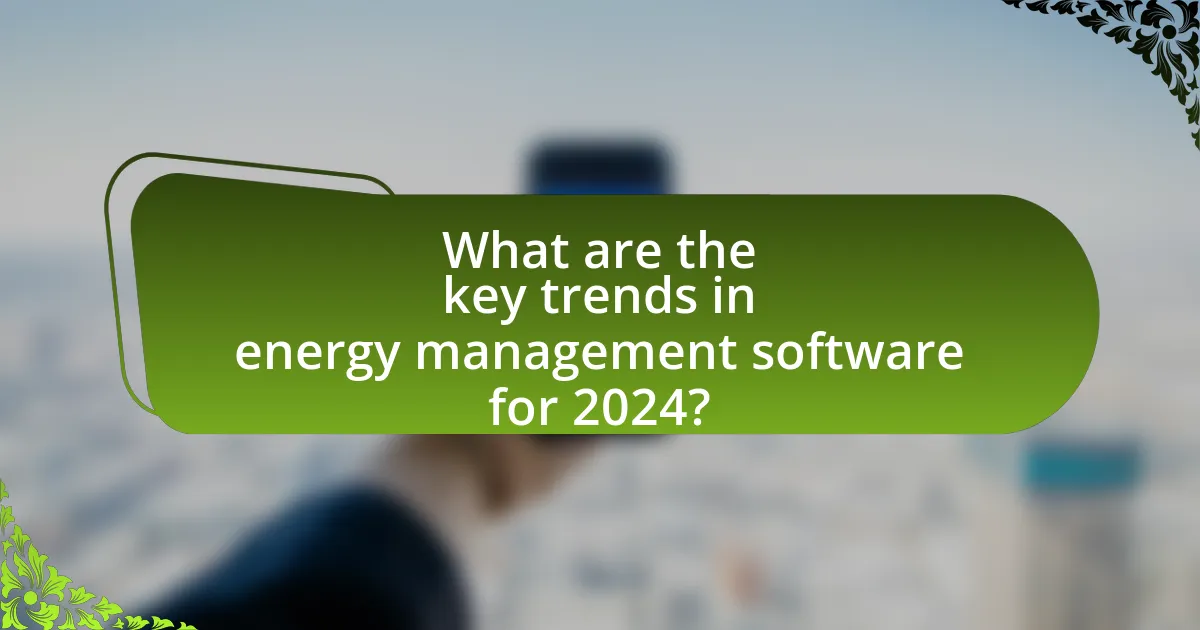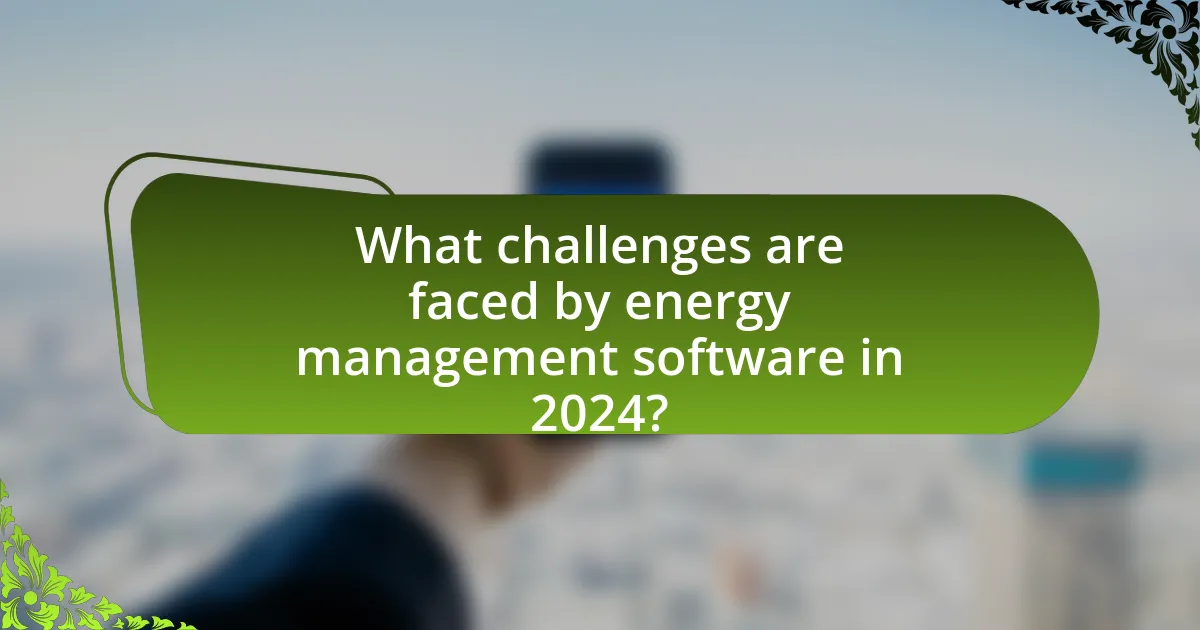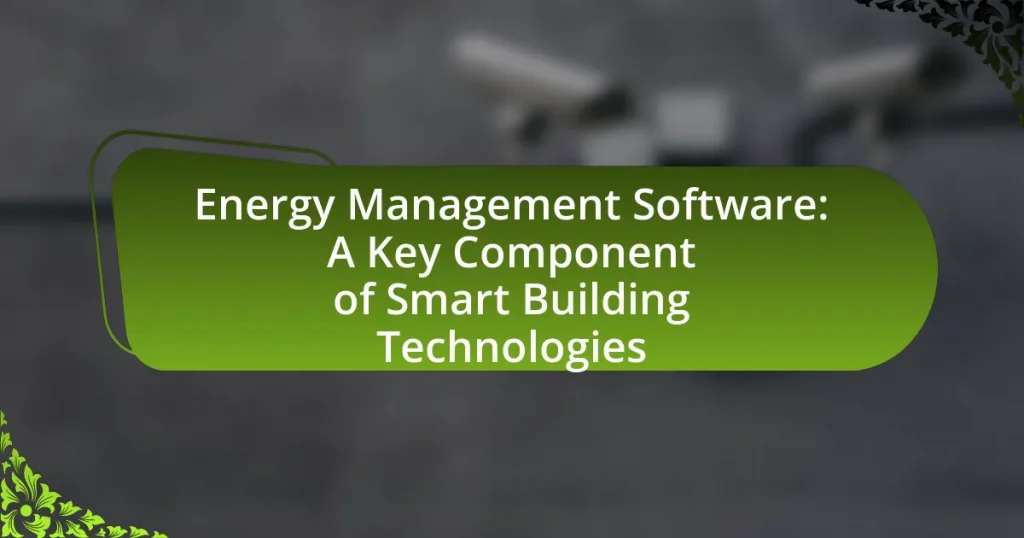The article focuses on the key trends in energy management software for 2024, highlighting the integration of artificial intelligence for predictive analytics, enhanced real-time data monitoring, and a strong emphasis on sustainability through carbon tracking features. It discusses how technological advancements, particularly the Internet of Things (IoT), are shaping these solutions, while also addressing regulatory changes and compliance requirements that impact software development. Additionally, the article examines emerging features, user experience priorities, and the challenges faced by energy management software, including cybersecurity threats and barriers to adoption. Future developments are anticipated to further enhance integration capabilities and user demands, shaping the evolution of energy management tools.

What are the key trends in energy management software for 2024?
Key trends in energy management software for 2024 include increased integration of artificial intelligence for predictive analytics, enhanced real-time data monitoring capabilities, and a focus on sustainability through carbon tracking features. Artificial intelligence will enable organizations to optimize energy consumption patterns by analyzing historical data and predicting future usage, thereby improving efficiency. Real-time monitoring will allow businesses to respond swiftly to energy fluctuations, reducing costs and enhancing operational performance. Additionally, the emphasis on sustainability will drive the development of features that help organizations track and reduce their carbon footprint, aligning with global climate goals. These trends reflect the growing demand for smarter, more efficient energy management solutions in response to evolving regulatory and environmental pressures.
How are technological advancements shaping energy management software?
Technological advancements are significantly shaping energy management software by enhancing data analytics, automation, and integration capabilities. These improvements allow for real-time monitoring and optimization of energy consumption, leading to increased efficiency and cost savings. For instance, the integration of Internet of Things (IoT) devices enables continuous data collection from various energy sources, which can be analyzed using advanced algorithms to identify patterns and anomalies. Additionally, machine learning algorithms are being employed to predict energy demand and optimize resource allocation, further streamlining operations. According to a report by MarketsandMarkets, the energy management software market is projected to grow from $5.3 billion in 2020 to $11.3 billion by 2026, highlighting the impact of these technological advancements on the industry.
What role does artificial intelligence play in energy management software?
Artificial intelligence plays a crucial role in energy management software by enabling predictive analytics, optimizing energy consumption, and enhancing decision-making processes. AI algorithms analyze vast amounts of data from various sources, such as smart meters and IoT devices, to forecast energy demand and identify patterns in usage. For instance, a study by the International Energy Agency in 2021 highlighted that AI-driven energy management systems could reduce energy consumption by up to 20% in commercial buildings. This capability allows organizations to implement more efficient energy strategies, ultimately leading to cost savings and reduced environmental impact.
How is the Internet of Things (IoT) influencing energy management solutions?
The Internet of Things (IoT) is significantly enhancing energy management solutions by enabling real-time data collection and analysis. IoT devices, such as smart meters and sensors, provide continuous monitoring of energy consumption patterns, allowing organizations to optimize their energy usage. For instance, a study by the International Energy Agency indicates that IoT applications can lead to energy savings of up to 30% in commercial buildings by facilitating better demand response and predictive maintenance. This integration of IoT technology not only improves operational efficiency but also supports sustainability goals by reducing overall energy waste.
What regulatory changes are impacting energy management software in 2024?
In 2024, regulatory changes impacting energy management software include stricter emissions standards and enhanced data privacy regulations. The U.S. Environmental Protection Agency (EPA) has introduced new guidelines aimed at reducing greenhouse gas emissions from industrial sources, which necessitates advanced tracking and reporting capabilities in energy management software. Additionally, the General Data Protection Regulation (GDPR) and similar laws in various jurisdictions are enforcing tighter controls on how energy data is collected, stored, and processed, compelling software developers to integrate robust data protection features. These changes are designed to promote sustainability and protect consumer privacy, thereby influencing the development and functionality of energy management solutions.
How do new energy policies affect software development?
New energy policies significantly influence software development by driving the creation of applications that optimize energy efficiency and compliance with regulations. As governments implement stricter emissions targets and renewable energy incentives, software developers are tasked with integrating features that monitor energy consumption, manage resources, and ensure adherence to these policies. For instance, the implementation of the European Union’s Green Deal has led to increased demand for software solutions that facilitate carbon tracking and reporting, compelling developers to innovate in areas such as data analytics and real-time monitoring systems. This shift not only enhances the functionality of energy management software but also aligns with market needs for sustainable practices, thereby validating the impact of energy policies on software development.
What compliance requirements should users be aware of?
Users should be aware of compliance requirements related to energy management software, including regulations such as the Energy Policy Act, ISO 50001 standards, and local energy efficiency mandates. These regulations ensure that energy management practices align with national and international standards for sustainability and efficiency. For instance, ISO 50001 provides a framework for organizations to manage energy performance, which is critical for compliance and can lead to significant cost savings and reduced environmental impact. Additionally, users must consider data privacy laws, such as GDPR, when handling energy consumption data to ensure compliance with personal data protection standards.
What are the emerging features in energy management software?
Emerging features in energy management software for 2024 include advanced analytics, real-time monitoring, and integration with renewable energy sources. Advanced analytics enable organizations to optimize energy consumption by analyzing usage patterns and predicting future needs, which can lead to significant cost savings. Real-time monitoring allows users to track energy usage instantaneously, facilitating immediate adjustments to reduce waste. Integration with renewable energy sources, such as solar and wind, supports sustainability goals and enhances energy resilience. These features are increasingly being adopted as businesses seek to improve efficiency and reduce their carbon footprint.
How is user experience being prioritized in new software designs?
User experience is being prioritized in new software designs through user-centered design principles, iterative testing, and integration of feedback mechanisms. These approaches ensure that software meets the needs and preferences of users, enhancing usability and satisfaction. For instance, a study by Nielsen Norman Group highlights that user-centered design can lead to a 50% increase in user satisfaction and a 30% reduction in errors. Additionally, incorporating real-time user feedback during the development process allows designers to make informed adjustments, further aligning the software with user expectations.
What data analytics capabilities are becoming standard?
Data analytics capabilities becoming standard include real-time data processing, predictive analytics, and advanced visualization tools. Real-time data processing allows organizations to analyze data as it is generated, enabling immediate decision-making. Predictive analytics utilizes historical data to forecast future trends, enhancing strategic planning. Advanced visualization tools facilitate the interpretation of complex data sets, making insights more accessible. According to a report by Gartner, 70% of organizations will prioritize real-time analytics by 2024, underscoring the growing importance of these capabilities in energy management software.

What challenges are faced by energy management software in 2024?
Energy management software in 2024 faces several challenges, including data integration, cybersecurity threats, and user adoption. Data integration remains a significant hurdle as organizations utilize diverse systems and platforms, making it difficult for energy management software to consolidate and analyze data effectively. Cybersecurity threats pose risks to sensitive energy data, necessitating robust security measures to protect against breaches. Additionally, user adoption is challenged by the complexity of software interfaces and the need for training, which can hinder effective utilization and limit the software’s potential benefits. These challenges highlight the need for ongoing innovation and support within the energy management software sector.
How are cybersecurity threats affecting energy management systems?
Cybersecurity threats are significantly impacting energy management systems by increasing vulnerabilities to data breaches and operational disruptions. These systems, which are crucial for optimizing energy consumption and ensuring grid stability, are increasingly targeted by cyberattacks, leading to potential financial losses and compromised safety. For instance, a report by the U.S. Department of Energy highlighted that 80% of energy companies experienced cyber incidents in the past year, underscoring the urgent need for enhanced security measures. As a result, energy management systems must evolve to incorporate advanced cybersecurity protocols to mitigate these risks and protect critical infrastructure.
What measures can be taken to enhance security in energy management software?
To enhance security in energy management software, implementing multi-factor authentication (MFA) is essential. MFA significantly reduces the risk of unauthorized access by requiring users to provide two or more verification factors, which can include something they know (password), something they have (security token), or something they are (biometric verification). According to a report by the Cybersecurity & Infrastructure Security Agency (CISA), MFA can block over 99% of automated cyberattacks, demonstrating its effectiveness in safeguarding sensitive data within energy management systems. Additionally, regular software updates and patch management are crucial, as they address vulnerabilities that could be exploited by attackers. The National Institute of Standards and Technology (NIST) emphasizes that timely updates are a fundamental aspect of maintaining software security.
How do data privacy concerns impact user trust in these systems?
Data privacy concerns significantly diminish user trust in energy management systems. When users perceive that their personal data may be mishandled or inadequately protected, they are less likely to engage with these systems. A survey by the Pew Research Center found that 79% of Americans expressed concern about how their data is used by companies, indicating a strong correlation between privacy apprehensions and trust levels. Consequently, energy management software providers must prioritize robust data protection measures to foster user confidence and encourage adoption.
What barriers to adoption exist for energy management software?
Barriers to adoption for energy management software include high initial costs, complexity of integration with existing systems, and lack of user training. High initial costs can deter organizations from investing in energy management solutions, as they may require significant upfront capital. Complexity of integration poses challenges, as many businesses have legacy systems that are not easily compatible with new software. Additionally, a lack of user training can lead to underutilization of the software, as employees may not fully understand how to leverage its features effectively. These factors collectively hinder the widespread adoption of energy management software in organizations.
How does cost influence the implementation of energy management solutions?
Cost significantly influences the implementation of energy management solutions by determining the feasibility and scope of such projects. Organizations often assess the initial investment required for software, hardware, and training against potential savings from energy efficiency improvements. For instance, a study by the International Energy Agency found that companies investing in energy management systems can achieve energy savings of 10-30%, which can offset implementation costs over time. Additionally, budget constraints may lead organizations to prioritize certain features or opt for less comprehensive solutions, impacting overall effectiveness. Thus, the cost directly affects decision-making processes and the extent to which energy management solutions are adopted.
What training and support challenges do organizations face?
Organizations face significant training and support challenges, primarily due to the rapid evolution of technology and the need for continuous skill development. Many employees struggle to keep pace with new energy management software features, leading to decreased efficiency and productivity. A study by the International Energy Agency highlights that 70% of organizations report difficulties in adequately training staff on new software tools, which can hinder effective energy management practices. Additionally, the lack of tailored support resources often results in employees feeling overwhelmed, further complicating the adoption of innovative solutions in energy management.

What future developments can we expect in energy management software beyond 2024?
Future developments in energy management software beyond 2024 will likely include enhanced integration of artificial intelligence and machine learning for predictive analytics, improved real-time data monitoring capabilities, and increased focus on sustainability metrics. These advancements will enable organizations to optimize energy consumption more effectively, reduce costs, and meet regulatory requirements. For instance, AI-driven algorithms can analyze historical energy usage patterns to forecast future demands, allowing for proactive energy management strategies. Additionally, the integration of IoT devices will facilitate seamless data collection and analysis, further enhancing operational efficiency and decision-making processes.
How will advancements in renewable energy sources influence software evolution?
Advancements in renewable energy sources will significantly influence software evolution by driving the development of more sophisticated energy management systems. As renewable energy technologies, such as solar and wind, become more prevalent, software will need to adapt to manage the complexities of variable energy generation and consumption patterns. For instance, the integration of real-time data analytics and machine learning algorithms will enhance predictive capabilities, allowing software to optimize energy distribution and storage. According to a report by the International Energy Agency, the share of renewables in global electricity generation is expected to reach 30% by 2024, necessitating advanced software solutions to handle this transition effectively. This shift will lead to innovations in grid management software, demand response applications, and energy forecasting tools, ultimately transforming how energy systems operate and are managed.
What integration capabilities will be necessary for future software?
Future software will require robust integration capabilities to connect seamlessly with various energy management systems, IoT devices, and data analytics platforms. These capabilities will enable real-time data exchange, enhance interoperability, and support advanced analytics for improved decision-making. For instance, the integration of Application Programming Interfaces (APIs) will facilitate communication between disparate systems, while cloud-based solutions will allow for scalable data storage and processing. Additionally, the adoption of standardized protocols, such as MQTT and RESTful services, will ensure compatibility across different platforms, thereby streamlining operations and enhancing user experience.
How might user demands shape the next generation of energy management tools?
User demands will significantly shape the next generation of energy management tools by driving the development of more user-friendly, customizable, and data-driven solutions. As consumers increasingly prioritize sustainability and cost efficiency, energy management tools will need to incorporate features that allow for real-time monitoring, predictive analytics, and integration with renewable energy sources. For instance, a report by the International Energy Agency indicates that 70% of consumers are willing to adopt smart energy solutions that provide personalized insights and recommendations. This trend suggests that energy management tools will evolve to meet these expectations, focusing on enhanced user interfaces and advanced functionalities that cater to individual preferences and behaviors.
What best practices should organizations follow when selecting energy management software?
Organizations should prioritize scalability, user-friendliness, and integration capabilities when selecting energy management software. Scalability ensures that the software can grow with the organization’s energy needs, allowing for future expansion without requiring a complete system overhaul. User-friendliness is crucial as it affects employee adoption and overall efficiency; software that is intuitive reduces training time and increases productivity. Integration capabilities are essential for seamless data exchange with existing systems, such as building management systems and utility data, which enhances the software’s effectiveness in providing comprehensive energy insights. According to a report by Navigant Research, organizations that choose software with strong integration features can achieve up to 30% more efficiency in energy management processes.
How can organizations assess their specific energy management needs?
Organizations can assess their specific energy management needs by conducting a comprehensive energy audit that evaluates current energy consumption patterns and identifies inefficiencies. This process typically involves analyzing historical energy usage data, assessing facility infrastructure, and engaging stakeholders to understand operational requirements. According to the U.S. Department of Energy, implementing energy audits can lead to energy savings of 5% to 30% by pinpointing areas for improvement. Additionally, organizations can utilize energy management software tools that provide real-time monitoring and analytics, enabling them to make informed decisions based on accurate data.
What criteria should be prioritized when evaluating software options?
When evaluating software options, prioritize functionality, user experience, integration capabilities, scalability, and cost. Functionality ensures the software meets specific needs, while user experience affects adoption and efficiency. Integration capabilities are crucial for seamless operation with existing systems, and scalability allows the software to grow with the organization. Cost must be assessed not only in terms of initial investment but also ongoing maintenance and potential hidden fees. These criteria are essential for making informed decisions that align with organizational goals and operational efficiency.



